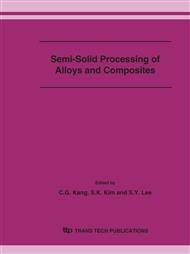p.489
p.493
p.497
p.501
p.505
p.509
p.513
p.518
p.522
Optimization of Heat Treatment Cycles for Automotive Parts Produced by Rheocasting Process
Abstract:
This work aims at studying the possibility of optimising the heat treatment cycles of parts produced using the New Rheocasting process in order to reduce the total cost of the operation, attaining good mechanical properties for high performance parts. The mechanical properties and the microstructure features of the considered A 356 alloy and the relative produced parts have been analysed and studied on samples machined both from the as cast and from the heat treated compomnents. The obtained results showed the possibility of successfully modifying the T6 heat treatment cycle with economical benefits, maintaining at the same time comparable high level properties and performances, together with good dimensional precision.
Info:
Periodical:
Pages:
505-508
Citation:
Online since:
October 2006
Authors:
Keywords:
Price:
Сopyright:
© 2006 Trans Tech Publications Ltd. All Rights Reserved
Share:
Citation:


